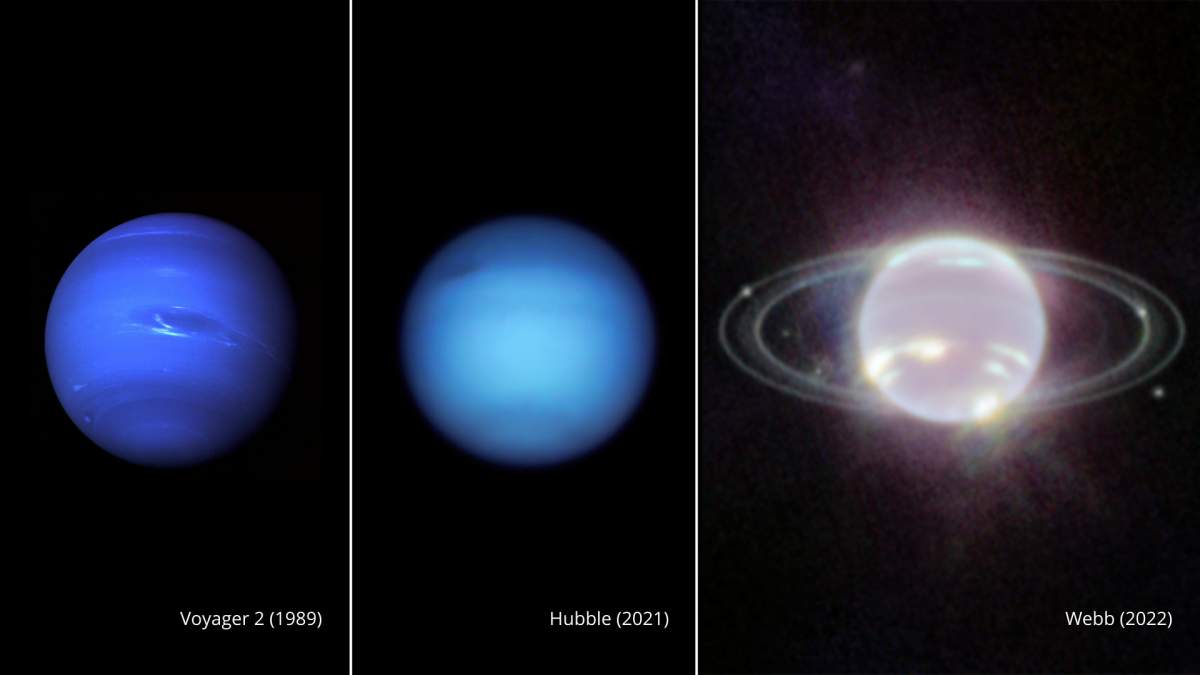The most recent images from the James Webb Space Telescope (JWST) are showing Neptune “in a whole new light,” according to NASA, who published the latest offerings of its $10 billion space-travelling observatory on Wednesday.

Before it captured Neptune on camera, the JWST was impressing the public with stellar photography of nebulas and galaxies in deep space. Now, it has turned its gaze back inwards to our solar system and captured a shot that might challenge your perception of the distant ice giant.
The images show Neptune with a luminous surface and two bright rings, spotted with numerous moons. NASA says they have captured the “clearest view” of Neptune in more than 30 years, when Voyager 2 observed Neptune for the first time during its flyby in 1989.
The telescope is providing scientists with an unprecedented glimpse at Neptune’s atmosphere — its bright streaks and spots actually being high-altitude clouds of methane gas reflecting the distant sunlight. The sun is so distant, in fact, that NASA says “high noon on Neptune is similar to a dim twilight on Earth.”
Mark McCaughrean, a senior advisor for science and exploration at the European Space Agency, told AFP that with the James Webb telescope “we can start to tease out the atmospheric composition” of the planet because Webb’s imaging “takes all that glare and background away.”

Get daily National news
When the Hubble telescope and Voyager both photographed Neptune, its surface appeared blue because of all the methane gas in its atmosphere absorbing red light. But in the near-infrared range captured by Webb, Neptune is in a greyish-white hue.
“The rings are more reflective in the infrared,” McCaughrean said, “so they’re much easier to see.”
Webb’s images show Neptune flanked by seven of its 14 known moons. What appears to be a bright, spiky star hovering above the planet is actually Triton, a moon of Neptune that NASA calls “large and unusual.”
Triton is covered in icy, condensed nitrogen that give it a sheen that reflects about 70 per cent of the sunlight it hits — far outshining the comparatively dim Neptune. NASA points out in its press release that Triton orbits Neptune in retrograde (backwards), leading astronomers to hypothesize that Triton was initially an object from the Kuiper belt that was “gravitationally captured” by Neptune.
NASA says it is planning on studying Neptune and Triton again with the Webb telescope.
The image also shows an “intriguing brightness” at Neptune’s northern pole, a portion of the planet that is just out of view to astronomers because of Neptune’s 164-year orbit. Neptune’s southern pole is facing Webb and the image shows a previously-known vortex there, but reveals that there’s a “continuous band of high altitude clouds surrounding it.”
The JWST is the successor to the Hubble Space Telescope, which has not only provided stunning images, but has also been vital in providing scientific knowledge about our universe and its origins.
The JWST has a much larger primary mirror than Hubble (2.7 times larger in diameter, or about six times larger in area), giving it more light-gathering power and greatly improved sensitivity over the Hubble.
When the JWST launched on Christmas Day 2021, there were no second chances — its extremely distant location in the solar system makes it impossible for human crews to visit for repairs.
Thomas Zurbuchen, NASA’s science mission chief, said that with the new telescope, the cosmos is “giving up secrets that had been there for many, many decades, centuries, millennia.”
“It’s not an image. It’s a new worldview that you’re going to see,” he said during a media briefing in July.
— with files from Global News’ Michelle Butterfield














Comments